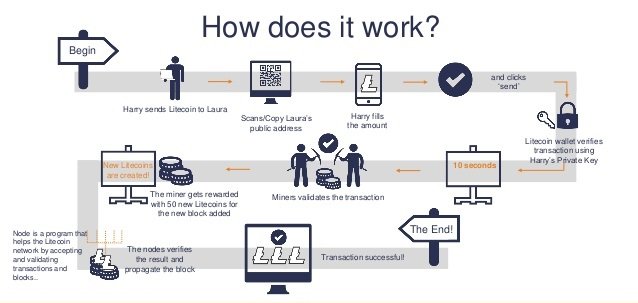How does Litecoin (LTC) work?
Introduction into the Workings of Litecoin
Litecoin exhibits itself as a peer-to-peer cryptocurrency operating in a very similar fashion as that of Bitcoin. However, while Litecoin is technically similar to Bitcoin, the two are not carbon copies.
So in this subsection of the Leo Finance Litecoin Coin Guide we will investigate in general terms what makes Litecoin work while pointing out its differences with Bitcoin. In this subsection, we will also give a brief look into how Litecoin is mined within the ecosystem.
How does Litecoin (LTC) work?
As noted above, Litecoin is a peer-to-peer cryptocurrency. As such, Litecoin permits users to transfer funds or make ordinary payments worldwide, quickly, and at a low cost per transaction. As Bitcoin may be seen more as a store of value, Litecoin has become the preference to facilitate purchasing.
Litecoin processes 56 transactions per second (tps). Bitcoin only processes 7 transactions per second (tps). The transaction fees on the Litecoin network are also extremely low, especially when viewed in comparison with Bitcoin and Paypal.
In the same fashion as Bitcoin, Litecoin are mined. As the coins on both networks are not issued by any central authority, neither ecosystem relies on a central financial authority to mint currency.
[For those totally new to the world of cryptocurrencies, mining is the mechanism networks utilize to process transactions and create new data blocks to be added to the network's distributed ledger. This has the effect of removing the necessity of any third party from the system].
The supply of Litecoin is exactly four times that of Bitcoin. As per CoinMarketCap. there is a maximum supply of 84,000,000 LTC and a maximum supply of 21,000,000 BTC. The reason for the increased maximum supply of LTC was the developers desire that the coin not become too scarce and thereby too expensive for use.
Without a doubt, the biggest difference between Bitcoin and Litecoin lies in the algorithm each uses to mine currency in the respective ecosystem. Bitcoin utilizes SHA-256 (Secure Hash Algorithm-256) which is GPU focused and promotes the use of ASICs and/or FPGA chip sets for mining. On the other hand, Litecoin employs the Scrypt algorithm for mining which is more accessible and energy efficient than SHA-256. As Scrypt is more accessible and democratic in nature, ASICs and FPGAs are prevented from monopolizing Litecoin mining permitting the 'regular joe' to be able to mine the coin.
The time for block generation differs between Bitcoin and Litecoin as well. With Litecoin, a new block is generated in the system every 2.5 minutes. With Bitcoin, it takes 10 minutes to generate a new block for the chain. This makes Litecoin a highly practical alternative for transaction processing over Bitcoin due to the increased system transaction speed.
How Does Litecoin Mining Work
The actual process of mining Litecoin may be view in the following simple illustration:
In a proof-of-work currency such as Litecoin, mining is the process of maintaining a distributed ledger of every transaction made on the blockchain's network.
The network participant's broadcast the various transactions since the preceding block was found which data is received by the miners. The miners then assemble the transactions into Merkle Trees and begin their work toward discovering an acceptable hash.
Within the Litecoin system, mining is competitive as being the first miner to generate a hash lower than the set target is the finder of the new block. By finding the new block the miner is entitled to receive the block reward of 12.5 LTC (at this time of this writing approximately $1,680.) plus all the transaction fees present in the block.
It should be noted that the block rewards, like with Bitcoin, are halved on a set schedule (roughly every four years after the passage of 840,000 blocks). Interestingly, Litecoin was designed so that when the last Bitcoin is mined, so too will be the last Litecoin mined.
A Final Reminder on the Workings of Litecoin
As noted at the onset of this subsection, from a technical standpoint Bitcoin and Litecoin share many similarities. However, there do exist significant differences between the two to set Litecoin and its use cases apart from those of Bitcoin for Litecoin to carve it's own cryptocurrency niche.
Posted Using LeoFinance Beta

:max_bytes(150000):strip_icc()/mine-5bfd714046e0fb002645e6f1)
I believe litcoin is like other coins, just that I don't remember the coin in my investment plan.
Posted Using LeoFinance Beta
Here is a TLDR
Litecoin is a lazy fork of bitcoin created by Charlie Lee. Charlie promised a lot of improvements to litecoin (like anonymous transactions) then suddenly dumped his bag at the very peak of price performance. He then left forever and price has never recovered.
Litecoin=garbage
Posted Using LeoFinance Beta
Ltc is so undervalued. It’s my goto coin for daily transactions outside of hive.
Posted using LeoFinance Mobile